Introduction:
With concrete slabs, the freshly-poured concrete may be retained by existing features, such as walls, kerbs , edgings etc, or some form of temporary shuttering, also known as 'Formwork' may be required. On vertical concrete structures, the construction of the formwork can become quite complicated and is normally undertaken by specialist formwork erectors or formwork carpenters. Ground slabs are normally much less complicated and require only the simplest of formwork.
In all cases, the formwork must be sturdy and capable of bearing the not inconsiderable forces created by wet concrete, plus the weight and force of any vibration equipment. Any joints in the formwork should be taped or sufficiently tight to prevent matrix leaking out during vibration and/or curing. The tops of any shutter or roadform should be set so as to provide an accurate edge from which the tamper or beam screed can operate.
There are two main types of formwork used for casting ground slabs: Steel "Roadform" and custom-made timber shuttering.
Roadform:
Roadform is popular amongst professional contractors for use on site as it is sturdy and tough, more then capable of withstanding the rough and tumble of a busy construction site and virtually unbreakable; it can be re-used time and time again, requires little skill to set-up and is cheap - single lengths can be hired for less than a couple of quid per week.

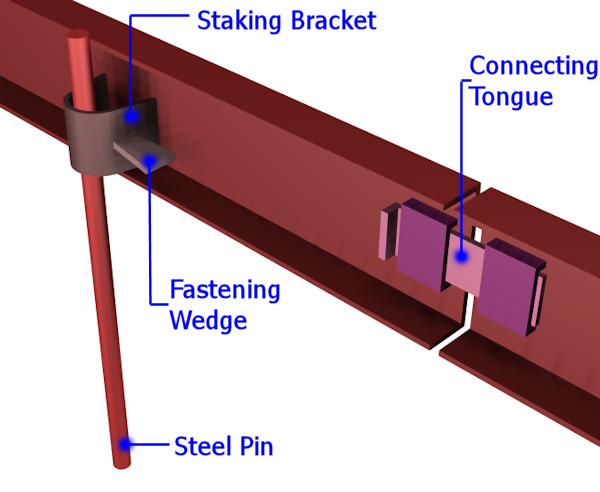
It consists of a channel-shaped steel section, normally 3 metres in length and either 100, 150 or 200mm in depth, with 3 fastening brackets fixed to the back edge and a sliding tongue-fitting that enables adjacent sections to be linked together. Units can be stacked to accommodate a greater depth of concrete, but never more than 2 units high, to a maximum height of 400mm, because of the limitations of bracing anything higher than that with the steel pins.
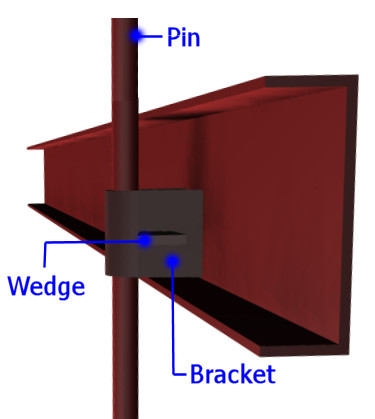
It is held in position by sturdy steel pins, normally 600mm in length, that are positioned within the staking bracket and driven into the ground with a hammer. Each section of roadform is aligned and then locked in place by tightening-up the fastening wedge so that it 'grips' the steel pin and holds the roadform in place
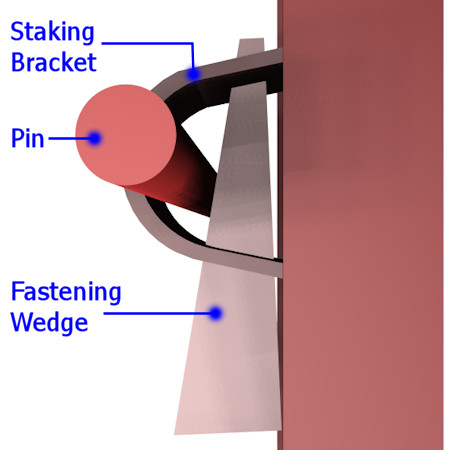
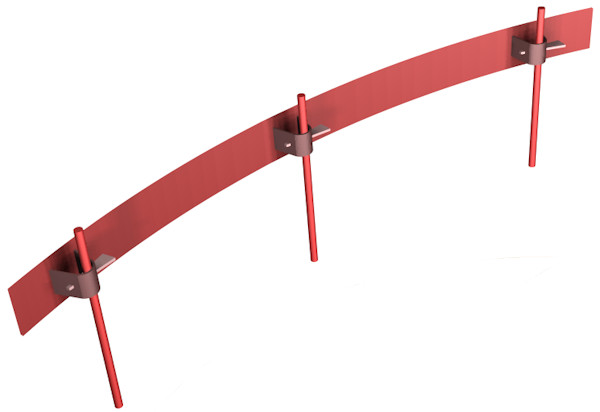
Along with the rigid sections, there is also a flexible version that can be bent to accommodate arcs and radii. It's only really suitable for radii of 2 metres or greater, although it can be 'persuaded' into faster arcs, up to around 1 metre radius, although 'persuading' it back afterwards can be even more problematic.
The usual method of erecting Roadform is to align the sections with the aid of a taut string line or a laser level to the required profile and to ensure that the faces of the sections are plumb (true vertical).
The staking pins must be firmly held by the sub-base/sub-grade and there should be no 'play' between sections. The tops of the steel stake pins should be below to top of the Roadform so that beam screeds or other screeding equipment can traverse the slab without hindrance.


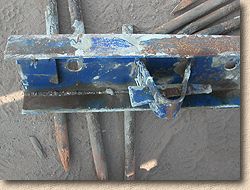
Note staking bracket and wedge fastener
Timber Shuttering:
While Roadform is the formwork of choice for simple slabs, there are situations where it is simply not possible of feasible to use it, and so the more traditional timber shuttering is used. The great advantage of timber shuttering over Roadform is that, because it is 'knocked-up' on site, it can be made to accommodate any situation, ranging from odd shapes, to greater depths. Timber shuttering is also the usual choice for vertical concrete work, although it is often used in conjunction with modular steel bracing elements.
The part of the shutter in contact with the concrete is known as the form lining, while the support timbers are collectively known as 'bracing' and consists of horizontal walers and vertical noggins. The size of timbers used for the bracing depend upon the size of the formwork; a simple 300mm high shutter for a ground slab may use 50x50mm timber to form the walers and noggins, whereas a 1 metre high shutter would be more likely to use 100x50mm timbers. The bracings are formed from straight and true timber and are always used end on, that is, the deepest way, to give as much support as possible.

The form lining is normally some form of plywood. 15mm or 18mm is the most commonly used, with WBP (Weather and Boil Proof) being preferred as it is less prone to delaminating in the damp conditions experienced by timber shuttering in contact with wet concrete and outdoors. Occasionally, hardboard may be used, or, increasingly, exterior grade MDF (Medium Density Fibreboard). On projects involving a substantial quantity of timber formwork, a film-faced special shuttering board may be used, but this is not always stocked by Builders' and Timber Merchants and needs to be ordered in advance.

Formwork carpentry is a specialist trade and for vertical structures, the bracing can become extremely complex, requiring design by structural engineers and the use of wedges to maintain alignment. Us simple folk in the groundworks trade, who rarely risk venturing above ground level, prefer to rely on straightforward raking braces to support the formwork we erect for ground slab construction.
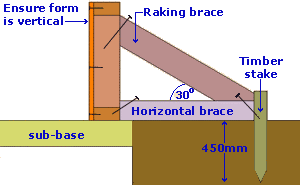
The spacing between walers and between noggins also depends on the size of the shutter, but is generally 300-600mm. Bracing timbers are usually the same size, if not bigger than the timber used for the walers and noggins. In some cases, adjustable steel props known as 'Acrows' may be used as raking or horizontal braces.
All brace members are securely fastened to the formwork, usually by nails, as they are easiest to withdraw when striking the formwork on completion of the work. This fastening is essential as it prevents the brace members 'springing', that is, flying loose under the pressure of the wet concrete and finishing equipment.
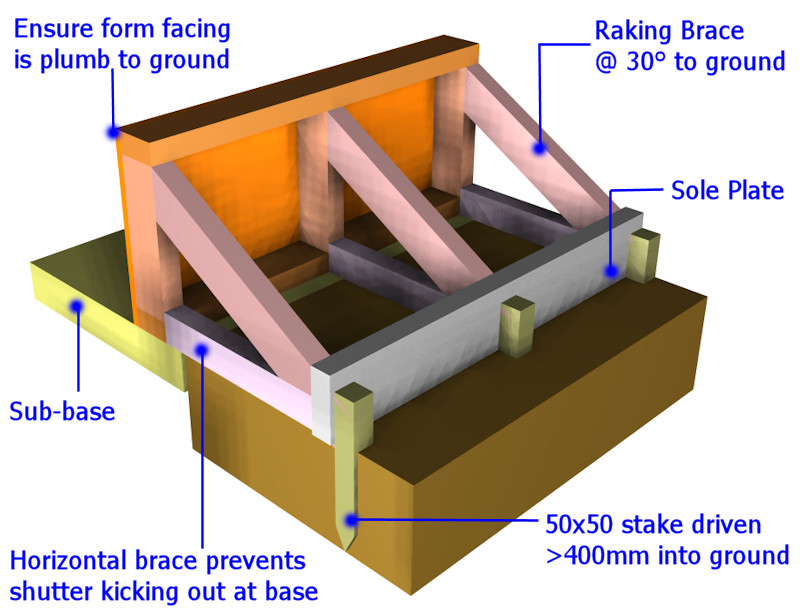
The ground pegs should be driven in to a depth of at least 450mm. In soft ground, a spreader board may be needed behind the peg to prevent it being forced back into the ground by the weight of the concrete. Alternatively, a "sole plate", usually a plank, will span several pegs and help spread the loading more evenly. The raking and horizontal braces will then be nailed to the sole plate.
When placing formwork over an existing solid base, such as a concrete slab or macadam surfacing, the same system of forms and bracing is used but often, rather than driving bracing pegs into the ground, the horizontal bracing will be affixed to the surface using masonry nails, screws, ground bolts or similar, as shown in the photograph below (kindly provided by GB Groundworks & Construction Ltd. )
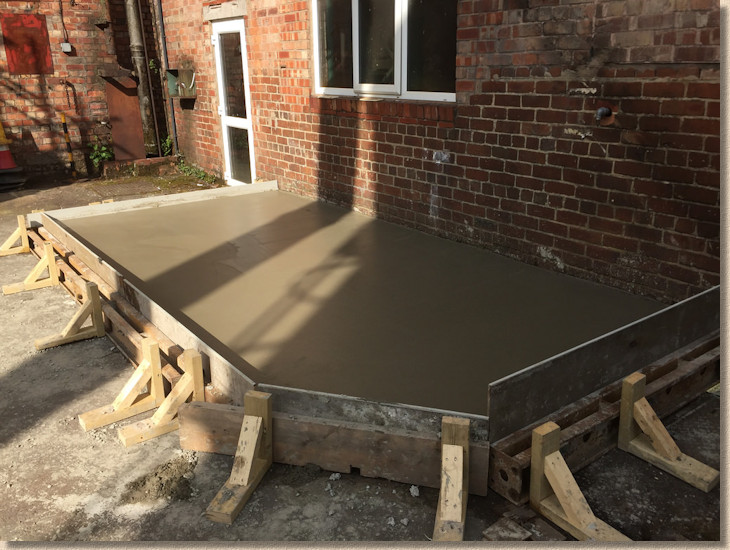
Flexible plywood can be used to construct the form lining to arcs and radii on timber shuttering. The plywood is traditionally 'kerfed' on one face to help the timber bend without breaking. This is done by sawing shallow notches (2-6mm deep) into the face or back of the form lining and then nailing it onto a pre-constructed waller bracing structure.
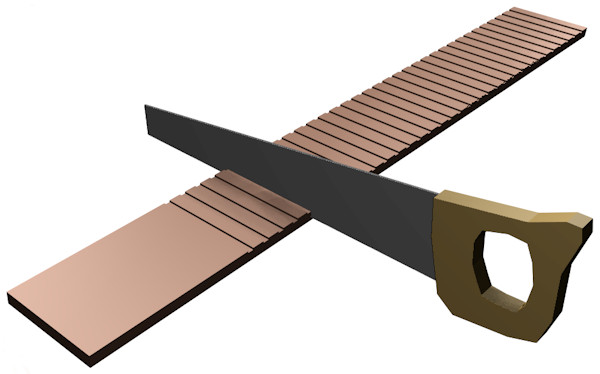

Release Agents
All formwork, whether is be steel roadform or timber shuttering, needs to be coated with a Release Agent (Mould Oil) before any concrete is placed. The purpose of a Release Agent is to prevent the concrete bonding to the formwork and then 'scabbing' when the formwork is removed. They also help ensure the formwork stays clean and free from concrete, so that it can easily be re-used elsewhere.
There are many products on the market that can be used as Release Agents for formwork, but the most commonly used is known as 'Soap Oil'. This liquid is painted onto the formwork in advance of the concrete being poured and it dries, leaving behind a soapy or waxy residue that has no deleterious effect on the concrete. Where the finish of the concrete is not important, some contractors will save themselves a few bob by using engine oil or diesel in place of a proper release agent; while there is nothing technically wrong with this practice, it's not exactly environmentally friendly and should be avoided whenever possible.
